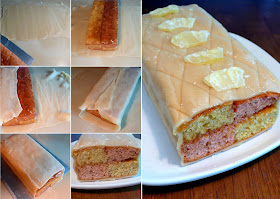| GINGERNUT-PINEAPPLE BATTENBERG CAKE |
No matter how
hard I try, I have not been able to divide batter equally just by
eye-balling it.
With this
Battenberg Cake, it looked like I had finally got it right, but it's
obvious from the picture that the pink portion is slightly bigger
than the yellow.
Maybe if I
close one eye... ;-|
The Daring
Bakers made this classic English cake for June. There was apparently
a hitch with hosting the challenge, but...
*trumpet
blast*
Mandy of What
The Fruitcake?! came to our rescue last minute to present us
with the Battenberg Cake challenge! She
highlighted Mary Berry’s techniques and recipes to allow us to
create this unique
little cake with ease.
Thanks
Mandy!
With Britain celebrating Queen Elizabeth II's royal diamond jubilee this year, this cake was apropos for the occasion. It's apparently an old German-style cake which used marzipan and has bright colours, and chefs of the Royal Family learnt the technique during the reign of Queen Victoria. They invented the cake to celebrate the marriage of the queen's granddaughter Princess
Victoria of Hesse and by Rhine and Prince Louis of Battenberg.
Mandy provided an excellent tutorial of the recipes and instructions on how to make different flavoured Battenberg Cakes.
 |
| First, bake the cake and assemble... |
I
thought ginger and pineapple would be a good match. So that both coloured
portions of the cake would have the same texture, the ginger half – flavoured
with powdered ginger – also has crushed gingernut biscuits in it, while the
flavour and texture of the pineapple half comes from minced candied pineapple.
The
colours of the two portions looked almost the same, so I had to add some food
gel. Pineapple would be yellow, of course, but pink was the closest I could get
to the colour of ginger.
 |
| ...then cover with marzipan and decorate |
I had a little trouble with the
marzipan and didn't do a neat job of wrapping the cake, but hey, when the loaf
was right side up, the top scored and decorated with candied pineapple slices, who could tell but me and the kitchen sink?
Was this a cake fit for a queen? Don’t know about the British monarch, but Mama, queen of the house of Ragavan, decreed that she would be taking several slices of it home with her.
Gingernut-Pineapple
Battenberg Cake
Serves
8-12
100g
butter, softened
100g
sugar
2
medium eggs
50g
ground almond
100g
plain flour
2
tsp baking powder
Pinch
of salt
1
tbsp milk
25g
gingernuts (2 biscuits), finely crushed
1
tsp powdered ginger
25g
candied pineapple (1 large ring), finely chopped
Red
and yellow food gels
To assemble
80ml
apricot jam, microwaved for a few seconds to soften
200g
marzipan
1
candied pineapple ring, cut into short lengths
Grease an 18cm square baking tin. Cut baking
parchment twice the length of the base of the tin. Make a crease in the centre
and fold up to fit into the base of the tin. Preheat oven to 170°C.
Beat the butter and sugar until light and creamy.
Add the eggs, one at a time, beating well after each addition. Mix in the
ground almonds.
Sift the flour, baking powder and salt together
three times. Fold flour mixture into the wet ingredients. The batter should be
a dropping consistency. If too firm, add a little milk.
Divide the mixture into two equal portions. Add
gingernuts and powdered ginger to one portion. Colour this portion with red
food gel. Add glace pineapple and yellow food gel to the other portion.
Place the two portions in separate sections of the
tin and bake cake for 20-25 minutes, until springy and a toothpick in the
centre comes out clean.
Cool cake on a wire rack for 10 minutes, then
remove from tin and cool completely.
Assembly
Cut each portion in two equally. two different
coloured logs together with apricot jam, and then sandwich the two pairs
together with more jam in a checkered pattern. Set aside.
Dust a large flat surface with icing sugar then
roll the marzipan in an oblong shape that is wide enough to cover the length of
the cake and long enough to completely wrap the cake. Brush the top of the cake
with apricot jam. Place the cake on the marzipan, jam side down. Brush the
remaining three sides with jam. Press the marzipan around the cake, making sure
the join is either neatly in the one corner, or will be underneath the cake
once turned over.
Carefully flip the cake over so that the seam is
under the cake and score the top of the cake with a knife in a criss-cross
pattern. Neaten the ends of the cake and remove excess marzipan by trimming off
a small bit of cake on both ends to reveal the pattern. Decorate the top with
pieces of candied pineapple.


